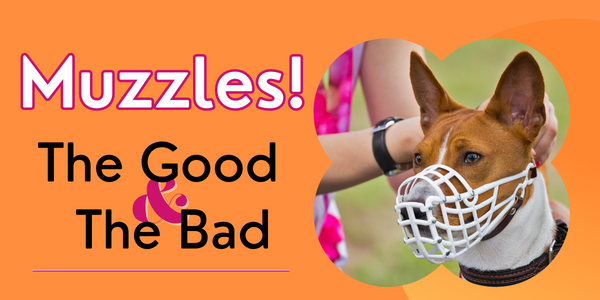Dog muzzles can sometimes get a bad reputation due to misconceptions and misunderstandings about their purpose and use. There are certainly pros and cons depending on the specific situation and how they are used.
Let’s begin with the muzzle cons (I’m starting with the shorter list!):
- Their use is misunderstood by many people.
- There is a perception of aggression or danger when a dog is seen wearing a muzzle.
- Some mistakenly think they are cruel or punishing.
- For many dogs to accept the wearing of a muzzle, conditioning must be done. That can take training time depending upon the dog.
It’s important to remember that muzzles, when used appropriately and with proper training, can be a helpful tool to ensure the safety of the dog and those around them.
There are so many pros to muzzle-wearing and if your dog needs one, it’s time now to begin conditioning your dog to accept it. Otherwise, your dog’s stress level when a muzzle is used, will be increased.
Here is the longer list of pros:
- Prevent harm: Muzzles can prevent your dog from biting in situations where they may feel anxious, scared, or threatened. A muzzle can prevent potential harm and provide a level of safety during interactions.
- Veterinary Visits: Muzzles can be used during veterinary examinations or treatments if a dog is anxious or fearful at the vet, or if there is a risk of the dog becoming aggressive due to discomfort or pain. For these dogs, training to comfortably accept a muzzle prior to any veterinary visit is critical. Dogs who can be safely handled by veterinary staff receive better care.
- Grooming and Handling: For dogs that become stressed or fear aggressive during grooming or handling, a muzzle can be used to protect groomers or handlers from potential bites.
- Injury or Pain: If a dog is injured or in pain, he or she might be more reactive and may attempt to bite when handled. A muzzle can be used temporarily during treatment or transportation to prevent any accidental bites.
- Safety: A muzzle can be used to keep your dog from eating things that could cause potential harm.
- Behavior Modification Training: In some cases, a muzzle can be used as a management tool during behavior modification training to address issues like reactivity or aggression. However, this should always be done under the guidance of a professional dog trainer.

Norrin is being trained to accept wearing the muzzle.
It’s important to emphasize that muzzles should not be used as a substitute for addressing underlying behavioral issues. Training, socialization, and behavior modification should be a priority to help the dog become more comfortable and less reactive in the long term. The muzzle will not change the dog’s underlying emotional issue. That must be dealt with separately, often with a professional.
It is critical that your dog be trained to accept the wearing of a muzzle. It’s very stressful to slap a muzzle onto a dog’s face without any prior conditioning. Also, it’s essential to ensure that the muzzle is properly fitted, comfortable and allows the dog to pant and drink water when necessary. For this reason, we recommend using a basket muzzle.
Muzzles should only be used for short periods, while supervised, and should never be used as a means of punishment, nor should it be used as a bandaid in situations that are known to cause a reaction.
If you are unsure whether using a muzzle is appropriate for your dog’s specific situation, it is best to consult with a professional dog trainer or a veterinarian who can provide personalized advice and guidance.
For a step-by-step plan to get your dog used to the muzzle, go to the Muzzle Up Project. And check out their Resources page for more valuable information.

